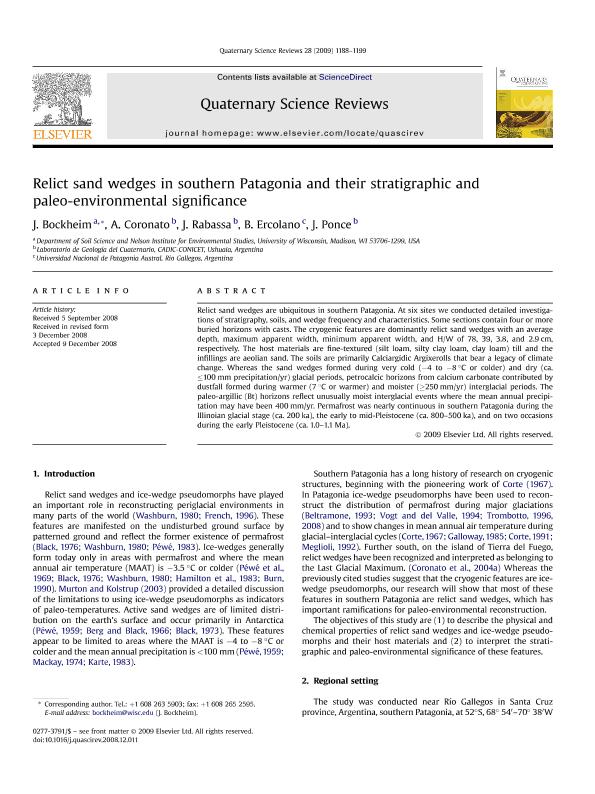Mostrar el registro sencillo del ítem
dc.contributor.author
Bockheim, J.
dc.contributor.author
Coronato, Andrea Maria Josefa

dc.contributor.author
Rabassa, Jorge Oscar

dc.contributor.author
Ercolano, Bettina

dc.contributor.author
Ponce, Juan Federico

dc.date.available
2021-06-04T14:35:48Z
dc.date.issued
2009-06
dc.identifier.citation
Bockheim, J.; Coronato, Andrea Maria Josefa; Rabassa, Jorge Oscar; Ercolano, Bettina; Ponce, Juan Federico; Relict sand wedges in southern Patagonia and their stratigraphic and paleo-environmental significance; Pergamon-Elsevier Science Ltd; Quaternary Science Reviews; 28; 13-14; 6-2009; 1188-1199
dc.identifier.issn
0277-3791
dc.identifier.uri
http://hdl.handle.net/11336/133223
dc.description.abstract
Relict sand wedges are ubiquitous in southern Patagonia. At six sites we conducted detailed investigations of stratigraphy, soils, and wedge frequency and characteristics. Some sections contain four or more buried horizons with casts. The cryogenic features are dominantly relict sand wedges with an average depth, maximum apparent width, minimum apparent width, and H/W of 78, 39, 3.8, and 2.9 cm, respectively. The host materials are fine-textured (silt loam, silty clay loam, clay loam) till and the infillings are aeolian sand. The soils are primarily Calciargidic Argixerolls that bear a legacy of climate change. Whereas the sand wedges formed during very cold (-4 to -8 °C or colder) and dry (ca. ≤100 mm precipitation/yr) glacial periods, petrocalcic horizons from calcium carbonate contributed by dustfall formed during warmer (7 °C or warmer) and moister (≥250 mm/yr) interglacial periods. The paleo-argillic (Bt) horizons reflect unusually moist interglacial events where the mean annual precipitation may have been 400 mm/yr. Permafrost was nearly continuous in southern Patagonia during the Illinoian glacial stage (ca. 200 ka), the early to mid-Pleistocene (ca. 800-500 ka), and on two occasions during the early Pleistocene (ca. 1.0-1.1 Ma).
dc.format
application/pdf
dc.language.iso
eng
dc.publisher
Pergamon-Elsevier Science Ltd

dc.rights
info:eu-repo/semantics/openAccess
dc.rights.uri
https://creativecommons.org/licenses/by-nc-sa/2.5/ar/
dc.subject
RELICT SAND WEDGES
dc.subject
SOUTHERN PATAGONIA
dc.subject
MIDDLE PLEISTOCENE
dc.subject
PERIGLACIAL ENVIRONMENTS
dc.subject.classification
Geología

dc.subject.classification
Ciencias de la Tierra y relacionadas con el Medio Ambiente

dc.subject.classification
CIENCIAS NATURALES Y EXACTAS

dc.title
Relict sand wedges in southern Patagonia and their stratigraphic and paleo-environmental significance
dc.type
info:eu-repo/semantics/article
dc.type
info:ar-repo/semantics/artículo
dc.type
info:eu-repo/semantics/publishedVersion
dc.date.updated
2021-03-26T13:05:13Z
dc.journal.volume
28
dc.journal.number
13-14
dc.journal.pagination
1188-1199
dc.journal.pais
Estados Unidos

dc.description.fil
Fil: Bockheim, J.. University of Wisconsin; Estados Unidos
dc.description.fil
Fil: Coronato, Andrea Maria Josefa. Consejo Nacional de Investigaciones Científicas y Técnicas. Centro Austral de Investigaciones Científicas; Argentina
dc.description.fil
Fil: Rabassa, Jorge Oscar. Consejo Nacional de Investigaciones Científicas y Técnicas. Centro Austral de Investigaciones Científicas; Argentina
dc.description.fil
Fil: Ercolano, Bettina. Universidad Austral; Argentina
dc.description.fil
Fil: Ponce, Juan Federico. Consejo Nacional de Investigaciones Científicas y Técnicas. Centro Austral de Investigaciones Científicas; Argentina
dc.journal.title
Quaternary Science Reviews

dc.relation.alternativeid
info:eu-repo/semantics/altIdentifier/url/https://www.sciencedirect.com/science/article/abs/pii/S0277379108003727
dc.relation.alternativeid
info:eu-repo/semantics/altIdentifier/doi/https://doi.org/10.1016/j.quascirev.2008.12.011
Archivos asociados
